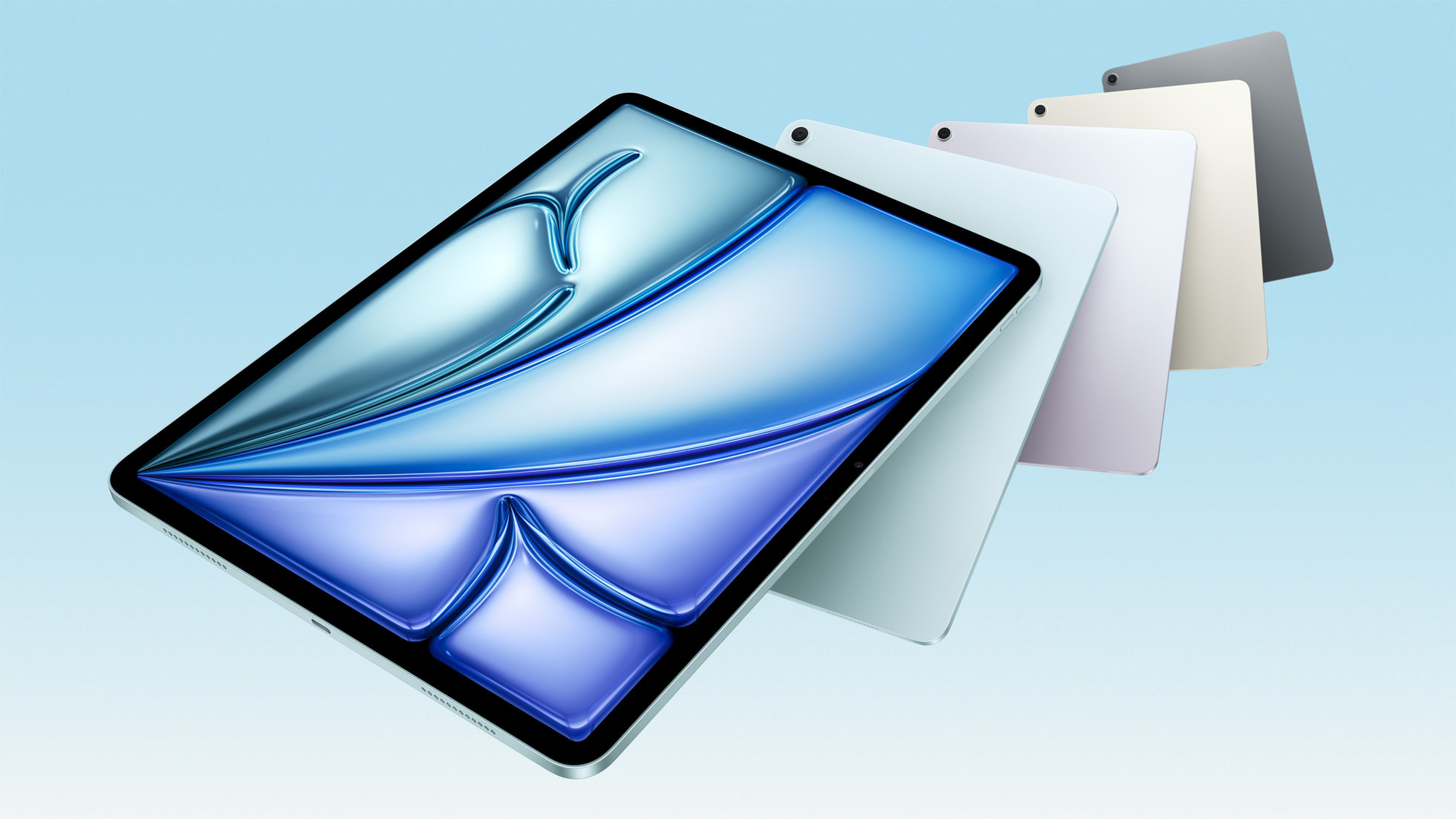Laptop Mag Verdict
The Lenovo Yoga Book C930 offers a host of innovations in an ultrathin chassis, but it's hamstrung by older components.
Pros
- +
Incredibly thin, light and versatile design
- +
Precision Pen delivers excellent writing experience
- +
Vibrant display
Cons
- -
Expensive
- -
Subpar battery life
- -
Not for touch typists
Why you can trust Laptop Mag
The road to innovation is filled with successes and hiccups. Case in point: the Lenovo Yoga Book C930. The successor to the original Yoga Book, the C930 maintains the things that blew me away about the original (colorful display, superthin and versatile chassis), and tweaks the mistakes from the previous model (difficult typing experience, limited stylus use) to make for a better experience overall. The addition of a triple-threat E Ink display that can transform from a keyboard to a notepad to an e-reader on a whim is sure to impress most consumers. But at $949 (Best Buy exclusive), the C930 is stymied by a last-generation processor and rather short battery life.
Lenovo Yoga Book C930 Price and Configurations
I typed, sketched and read on the $949 model of the C930, which has a 1.2-GHz Intel Core i5-7Y54 processor with 4GB of RAM, a 128GB SSD and an Intel HD 615 GPU. If you want more storage, you can get the 256GB version for $1,049.
Design: Aggressively Thin
The C930 is thin. How thin? So thin that there wasn't enough space to add a headphone jack. So thin that my mom didn't think it was a computer at first glance. In other words, it's superthin. At 1.7 pounds, 10.3 x 7.1 x 0.4 inches, the only thing slimmer on the market is the Microsoft Surface Pro 6 (1.7 pounds, 11.5 x 7.9 x 0.3 inches). The Google PixelBook is a bit heavier than the C930 at 2.5 pounds, but shares a similar svelteness at 11.4 x 8.7 x 0.4 inches.
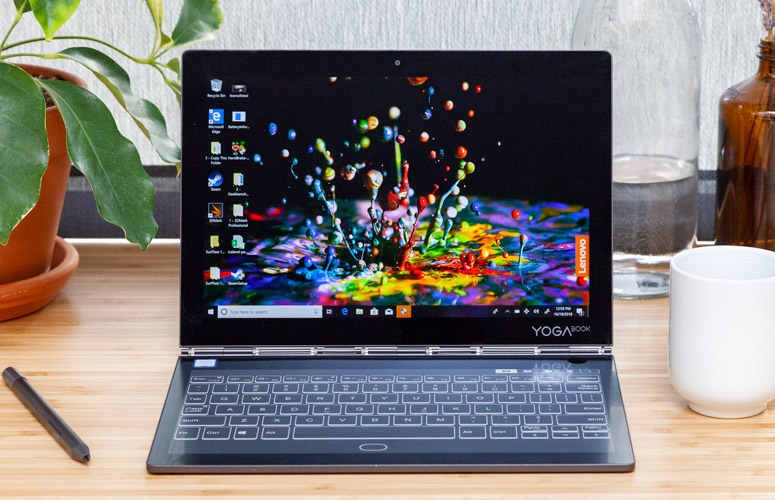
But in addition to being thin, the C930 is also restrained and refined. The exterior chassis is made from iron-gray aluminum, a material that belies the system's perceived fragility due to its slim dimensions. Adornments are minimal, with only a glossy Lenovo emblem in the bottom-left corner and the gleaming gears of the watchband hinge.
Never one to incorporate form without function, the hinge allows the C930 to seamlessly transition between several modes, including a traditional laptop, tent, tablet and collaboration, where it lies completely flat, allowing two or more people to gather round.
MORE: Best Lenovo Laptops
If you're unfamiliar with the Yoga Book line, you're going to get quite a shock when you open it. Instead of the traditional island-style keyboard, there's a digital E Ink keypad. At the top of the panel in the top-right corner sits the fingerprint reader. The 10.8-inch display resides at the top half of the setup, surrounded by a fairly thick border. A Yoga Book emblem in the bottom right adds a touch of pizzazz.
Ports
When you've got such a slender system, there isn't much room for ports.
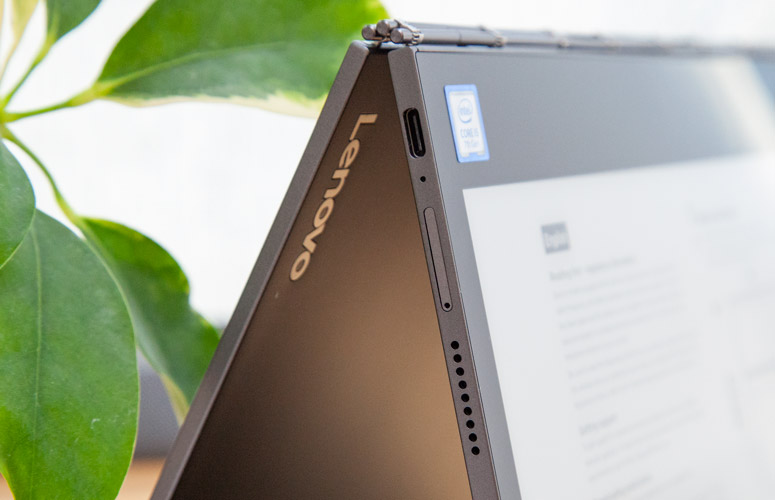
The company managed to fit a pair of USB Type-C ports along the sides along with a microSD/SIM card slot and buttons for power and volume.
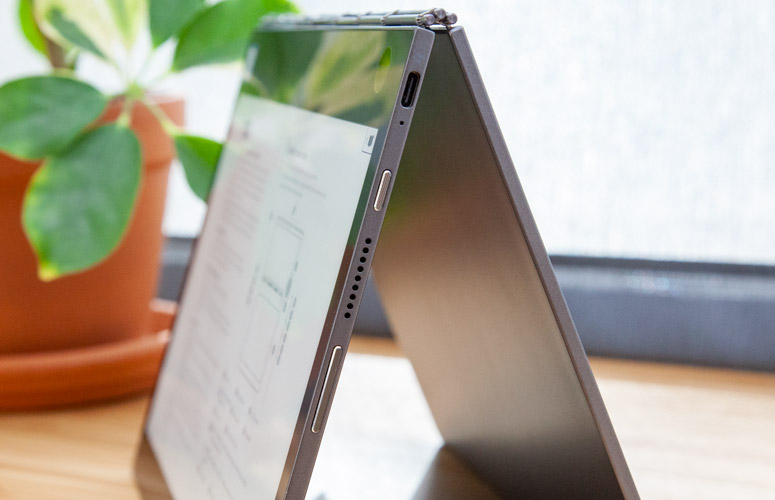
Please knock before computing
Unlike many other laptops, the C930 doesn't have a front lip to help you open the laptop, which makes gaining access a little difficult unless you have nails. To alleviate this seeming design faux paux, Lenovo has instituted a fun and clever method of entry: just knock.
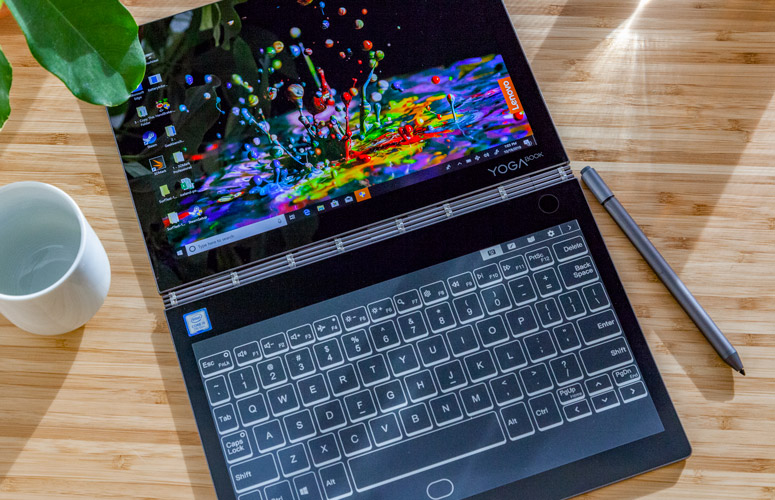
That's right, Lenovo has created a Knock to Open feature where you tap twice on the lid to make it pop open. I've had about an 80 percent success rate with Knock to Open and found I've gotten the most success when knocking near the corners of the laptop instead of dead center.
It's a fun way to open the laptop, although I got quite a few stares when I did it in my local coffee shop. Folks looked at me like I was committing gadget abuse. If you're not a fan of hitting your tech, you can also open the laptop by holding down the volume up button for a few seconds. Still, all of this seems more gimmicky than practical.
Display
The C930's 10.8-inch, 2560 x 1600 (QHD) IPS touch display produces vibrant color and is fairly bright. However, in an era of ever-shrinking bezels, I wish Lenovo fit an even larger screen into the mix by cutting down the chunky bezels.
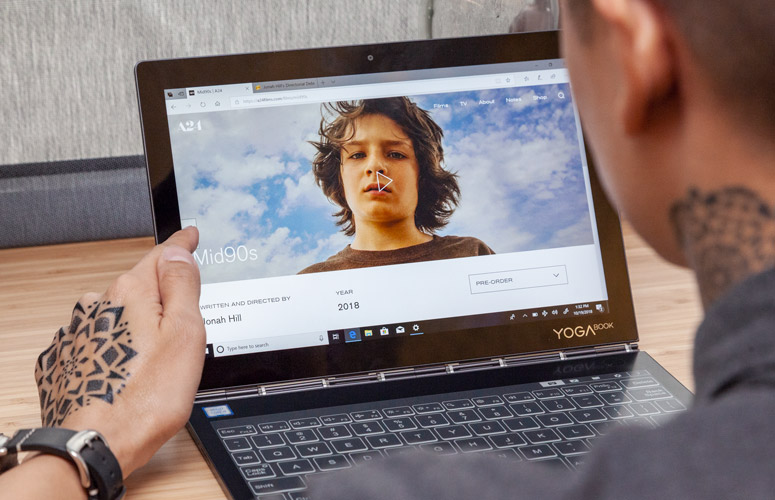
I wasn't pleased with the constant stream of rich color as I watched the If Beale Street Could Talk trailer. I could see the slight touch of blush highlighting actress Kiki Layne's warm, brown skin. The blue and red flowers on her white shirt drew the eye as did her red, green and yellow headband. Details were fine enough that I could clearly see the curl pattern in her coiffed afro.
The C930's screen can produce 144 percent of the sRGB color gamut, beating the 115-percent premium laptop average. The Surface Pro 6 wasn't too far behind at 136 percent, while the Pixelbook delivered a respectable 117 percent.
Averaging 342 nits of brightness, the C930 outshone the 311-nit category average. However, it couldn't hold a candle to either the Pixelbook (421 nits) or the Surface Pro 6 (408).
MORE: Laptops with the Most Colorful Screens
The touch screen was very responsive to my touches, quickly carrying out pinch-zoom and scrolling gestures.
Audio
The Yoga Book's side-mounted speakers aren't particularly loud, but they pump out surprisingly rich sound. When I listened to Ledisi's "Anything," I heard crisp percussion and clean strings coupled with Ledisi's thrilling alto. Despite just barely filling my medium-size bedroom, I was pleasantly surprised by how well the speakers handled the electric guitar solo.
Besides the overall volume, the speakers' only weakness was the lack of bass, which was practically nonexistent. I got some hints of the low end when I started messing with the Dolby Atmos software, but not enough to make a difference.
Keyboard: A step in the right direction
The Yoga Book's E Ink keyboard is still the purview of those who specialize in the much-maligned hunt-and-peck method. However, Lenovo has managed to improve the experience visually, aurally and physically. Now when you type, the keys animate as if they're being pressed down. The effect is enhanced with haptic feedback and keyboard audio, both of which can be adjusted in settings.
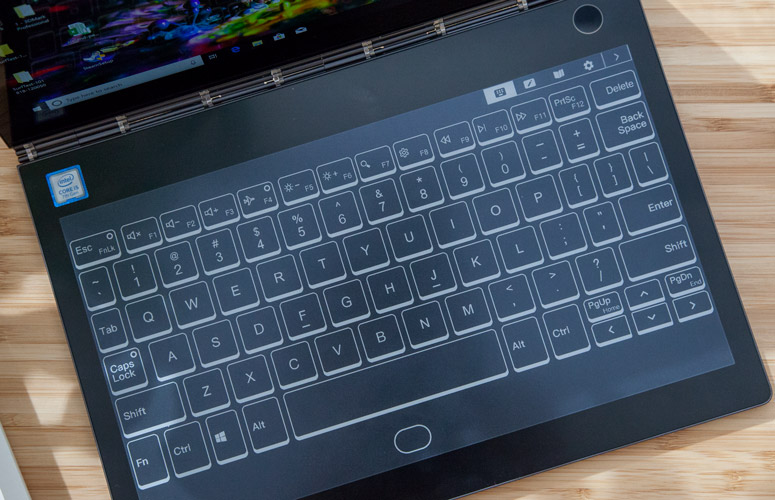
Other improvements Lenovo incorporated include larger keys, which made it easier to type. The keyboard also features artificial intelligence that will learn your typing habits over time. So if you tend to overextend your pinkie and hit Right Shift instead of the comma, the laptop will correct the input accordingly.
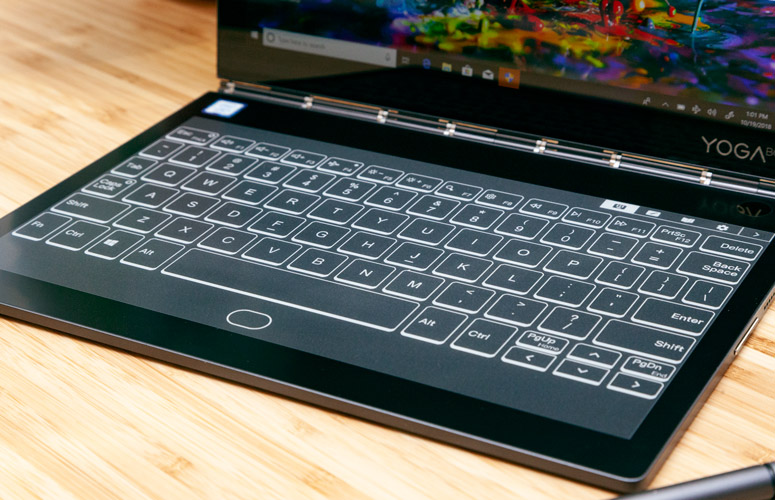
The keyboard also has two modes: classic and modern. Classic is your typical keyboard setup, complete with touchpad. However, to make room for the touchpad, the keys are smaller, which slightly affected my typing score. I manage to hit only 25 words per minute on the 10fastfingers typing test in this mode. Modern mode swaps out the touchpad for a circular button that you tap when you're ready to use the former. My typing rate jumped to 34 wpm, which is better than Classic, but still far below my typical 70 wpm.
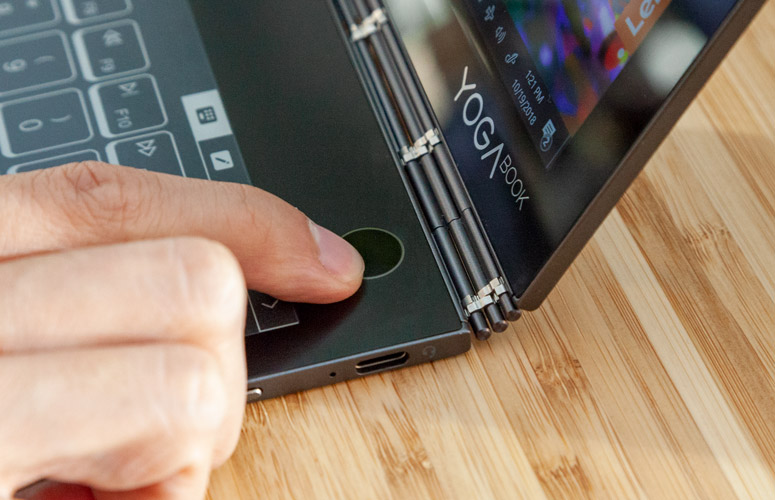
Overall, I prefer the modern version of the keyboard since I get better accuracy. However, having to physically access the touchpad can be a bit jarring. And since the touchpad is smaller than most, I often found myself hitting the spacebar, which made the touchpad disappear.
MORE: The Best Laptops for Every Need
At 2.6 x 1.5 inches, the touchpad is smaller than your average touchpad, and without physical ridges to guide me, I often found myself traveling outside the virtual borders and hitting other keys. Finger mishaps aside, the digital touchpad functions just as good as a physical one, performing pinch-zooms, two- and three-finger swipes and even tap gestures accurately. The fins posted on the sides of the pad act as the left and right mouse buttons.
Note Mode
Lenovo's ditched the physical notepad in favor of an E Ink one beneath the main display, and the Yoga Book is better for it. Combined with the company's Precision Pen, taking notes or sketching a picture was fluid, intuitive and self-contained.
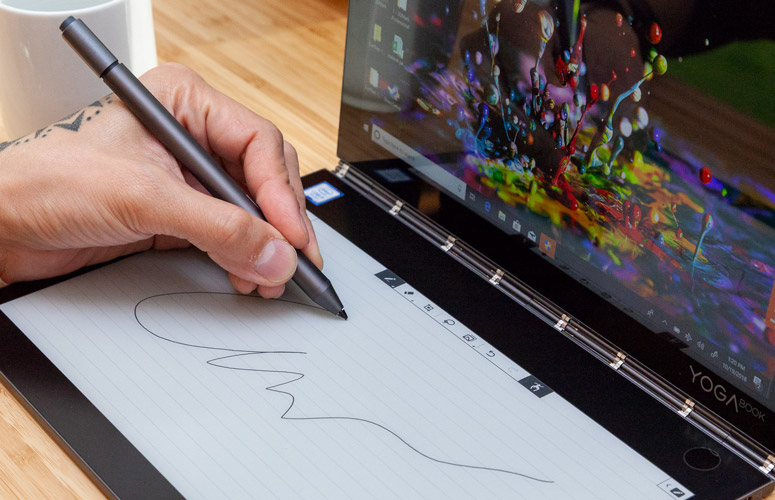
The Bluetooth-enabled writing implement offers 4,096 points, or pressure sensitivity, and can be used with either the E Ink or the regular panel. When not in use, the magnetic pen attaches securely to the C930's lid.
At 0.5 ounces, it's just as solid as a traditional pen but has quite a few more tricks up its sleeve. Clicking the button at the back of the Pen launches Note Mode on the E Ink display, while two clicks opens Windows Ink. There's also an elongated button near the pen tip, pressing the top half of the button initiates the eraser in Windows Ink, while the bottom half acts as the left mouse button in Windows and performs Copy on the E Ink panel.
Whether I was writing on the QHD display or the E Ink panel, the pen delivered a fluid experience. The pen nimbly kept pace with my fevered scribblings, whether I was doing my normal script or putting a little more effort in with cursive. Depending on how hard I pressed or how I held the pen, I saw thinner or bolder pen strokes.
The biggest difference between writing on the two screens is resistance. Writing on the glass panel was reliably smooth, which is nice, but doesn't really capture the feeling of writing on paper. Despite being just as smooth as its glass counterpart, writing on the E Ink panel offers just a slight hint of drag that makes me feel like I'm pulling my pen across an expensive grade of paper. It's soothing and made me be a bit more deliberate with my work.
MORE: Best and Worst Laptop Brands
While I like the experience of taking notes on the E Ink screen, I really wish Lenovo would let you add multiple pages to a note. Having to create a whole new entry is annoying, especially if I'm taking notes about the same event. I did, however, appreciate Lenovo's dedication to power conservation. When you use the E Ink panel in tablet mode, you can turn the LCD panel off by double-tapping the E Ink display. It's a handy feature that can extend the convertible's battery in a pinch.
Reader Mode
Sometimes you just want to curl up with a good book. For those cases, the C930's Reader mode can come in handy, or at least it will. Unfortunately, Reader mode currently only works with PDFs, so you'll have to wait until January to access other content like eBooks. For now, I had to make due with reading a few PDFs instead of Tomi Adeyemi's Children of Blood and Bone.
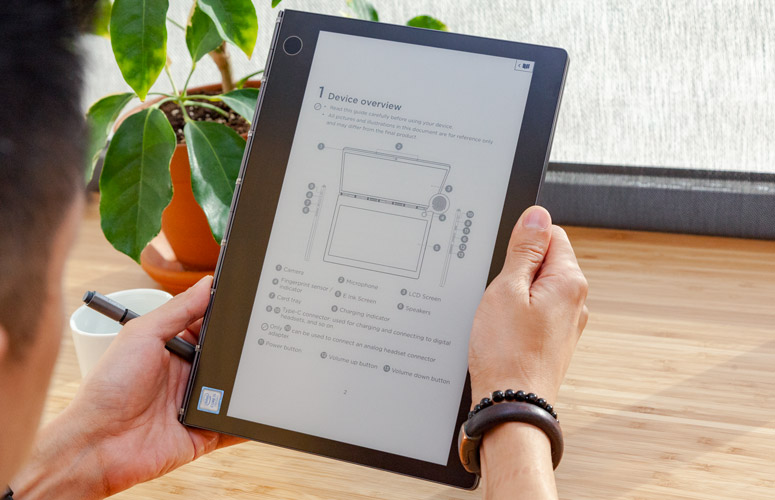
The experience is pretty straight forward. After selecting Reader mode on the E Ink display, you click the Open Document button and choose your reading material. From there, your content is ready to go. There are shortcuts to capture notes, zoom in and out, and copy pages. If you change the system's orientation to landscape mode, you can place pages side by side.
Text on the E Ink panel was sharp and easy to read. Scrolling through pages was quick, taking less than a second to load. It should be a great e-reader -- when that functionality becomes available.
Performance
Armed with a 7th Gen 1.2-GHz Intel Core i5-7Y54 processor with 4GB of RAM, the C930 is a blast from a not-too-far-gone past. Despite being a little out of date, the C930 is still a capable workhorse, allowing me to watch The Dragon Prince on Netflix with 14 additional tabs running in Google Chrome, some of which were streaming from Twitch, running Slack or playing a YouTube video.
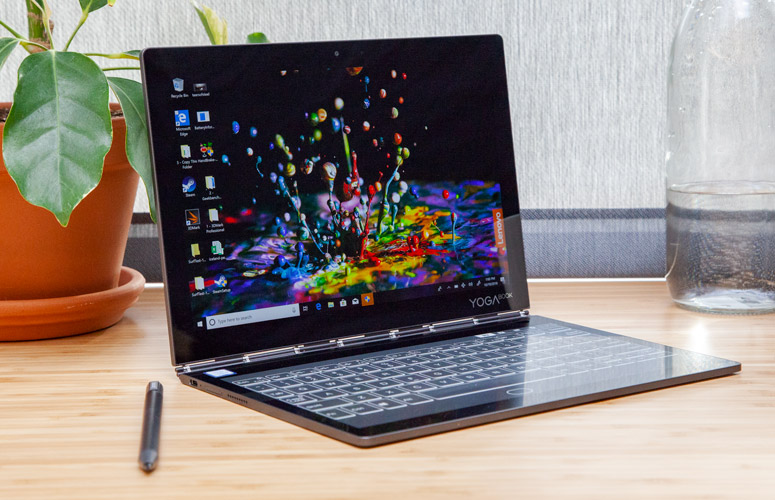
But when it came to some of our synthetic benchmarks, the C930 was simply underpowered. The 2-in-1 scored only 6,531 on Geekbench 4, which measures overall performance. That's well below the 12,446 premium-laptop average. The Pixelbook and its 1.2-GHz Intel Core i5-7Y57 CPU did somewhat better at 7,927 while the Surface Pro 6 with its 8th Gen 1.6-GHz Intel Core i5-8750U processor achieved a score of 13,025.
When we ran our productivity test (matching 65,000 names and addresses in Microsoft Excel), the C930 finished the job in 3 minutes and 23 seconds, which is slower than the 1:30 average. The Surface Pro 6 was nearly twice as fast with a time of 1:15.
The C930's 128GB SSD took 21 seconds to copy 4.97GB of mixed-media files, which translates to a 242 megabytes-per-second transfer rate. It's short of the 480.9 MBps average, but was better than the Surface Pro 6's (128GB SSD) 203 MBps.
The C930 is only outfitted with an Intel HD 615 graphics chip, which means you can't play some of the more demanding titles like Shadow of the Tomb Raider. But you should be able to enjoy older titles like BioShock Infinite.
MORE: Laptops with the Best Productivity Performance
The 2-in-1 ran the racing game Dirt 3 at our 30 frames-per-second threshold. It's below the 76-fps average, but still playable. The Surface Pro delivered a much higher 81 fps. On the synthetic 3DMark Unlimited test, the C930 hit 51,245, missing the 89,766 average and the Surface Pro 6's 73,697.
Battery Life
Lenovo claims that the C930 will last 8.6 hours on a charge (using the MobileMark test). However, the system lasted only 6 hours and 30 minutes on the Laptop Mag battery test (continuous web surfing over Wi-Fi at 150 nits of brightness). That's less than the 8:36 average as well as the times posted by the PixelBook (7:43) and Surface Pro 6 (9:20).
Heat
The C930 got a bit warm during our testing. After 15 minutes of streaming an HD video, the touchpad and middle of the keyboard measured 88 and 92 degrees Fahrenheit. The bottom was noticeably warmer at 103 degrees, which is hotter than our 95-degree comfort threshold. Still, my lap didn't feel too hot after using this system for over an hour.
Webcam
The C930's integrated 2-megapixel webcam served up grainy detail with relatively accurate color.
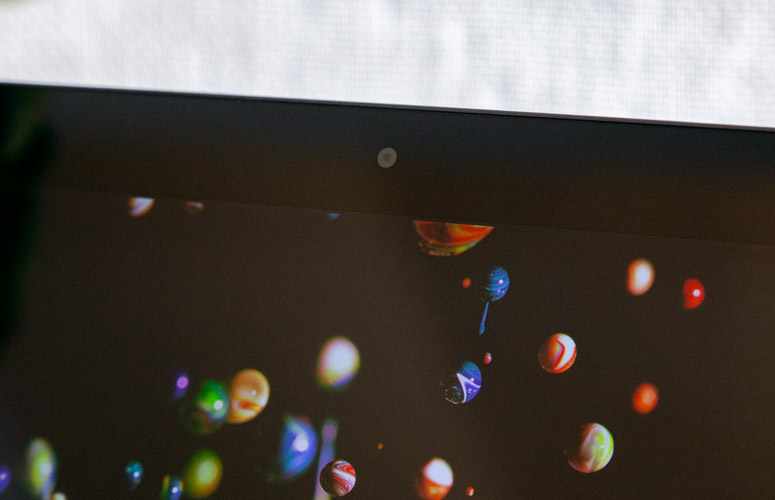
My brown skin looked warm and inviting, but you could barely see the knit pattern in my beige sweater.
Software and Warranty
Surprisingly, the Yoga Book C930 isn't weighed down with a lot of bloatware or manufacturer-branded apps. You get Lenovo Vantage, which allows you to check the notebook's diagnostics and hardware settings as well as receive helpful tips on getting the best performance out of your system.
There's your usual cadre of Windows 10 bloatware, including Candy Crush Saga, Candy Crush Soda Saga, Royal Revolt 2, Drawboard PDF, Dolby Access and Hidden City: Hidden Object Adventure.
MORE: Best Hard Drive Speed
The Lenovo Yoga Book C930 ships with a one-year limited warranty with parts and labor. See how Lenovo fared on our annual Tech Support Showdown and Best and Worst Laptop Brands special reports.
Bottom Line
The Yoga Book C930 is what happens when companies throw caution to the wind and just create. Lenovo successfully melded a laptop, tablet, note-taking device and e-reader into one incredible slim, stylish chassis. Thanks to some clever haptics and audio, the E Ink display offers a better typing experience than its predecessor. I still wouldn't recommend it for touch typists like myself, but it's definitely improved. The pen is one of best parts of the experience as writing on either surface is smooth and natural.
However, for $949, the C930 is overpriced for something that would ultimately be used as a secondary device. At that price, it should have a current-gen processor, especially since that price range puts it in direct competition with the $1,299 Microsoft Surface Pro 6, which offers better performance, battery life and typing. I like the C930, but Lenovo still has a ways to go before more people embrace this bold concept.
Credit: Laptop Mag
Lenovo Yoga Book C930 Specs
| Bluetooth | Bluetooth 4.2 |
| Brand | Lenovo |
| CPU | 1.2-GHz Intel Core i5-7Y54 processor |
| Card Slots | SIM, microSD |
| Company Website | www.lenovo.com |
| Display Size | 10.8 |
| Graphics Card | Intel HD 615 GPU |
| Hard Drive Size | 128GB |
| Hard Drive Speed | n/a |
| Hard Drive Type | SSD |
| Highest Available Resolution | 2560 x 1600 |
| Native Resolution | 2560 x 1600 |
| Operating System | Windows 10 Home |
| Optical Drive | None |
| Optical Drive Speed | n/a |
| Ports (excluding USB) | USB Type-C, Fingerprint Scanner |
| RAM | 4GB |
| Size | 10.3 x 7.1 x 0.4 inches |
| Touchpad Size | 2.5 x 1.6 inches |
| USB Ports | 2 |
| Warranty/Support | 1 year limited warranty |
| Weight | 1.7 pounds |
| Wi-Fi | 802.11 a/b/g/n/ac |

Sherri L. Smith has been cranking out product reviews for Laptopmag.com since 2011. In that time, she's reviewed more than her share of laptops, tablets, smartphones and everything in between. The resident gamer and audio junkie, Sherri was previously a managing editor for Black Web 2.0 and contributed to BET.Com and Popgadget.
